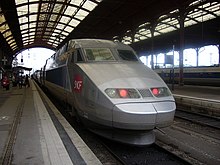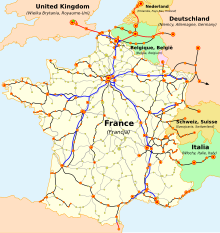Appenweier – Strasbourg railway line
| Appenweier – Strasbourg | |||||||||||||||||||||||||||||||||||||||||||||||||||||||||||||||||||||||||||||||||||||||||||||||||||||||||
|---|---|---|---|---|---|---|---|---|---|---|---|---|---|---|---|---|---|---|---|---|---|---|---|---|---|---|---|---|---|---|---|---|---|---|---|---|---|---|---|---|---|---|---|---|---|---|---|---|---|---|---|---|---|---|---|---|---|---|---|---|---|---|---|---|---|---|---|---|---|---|---|---|---|---|---|---|---|---|---|---|---|---|---|---|---|---|---|---|---|---|---|---|---|---|---|---|---|---|---|---|---|---|---|---|---|
| Route number (DB) : | 4260 (Appenweier-Nord – Kehl border) 4261 (App.-Muhrhaag-App. Curve) |
||||||||||||||||||||||||||||||||||||||||||||||||||||||||||||||||||||||||||||||||||||||||||||||||||||||||
| Route number (SNCF) : | 142 000 (Strasbourg Ville – Kehl border) | ||||||||||||||||||||||||||||||||||||||||||||||||||||||||||||||||||||||||||||||||||||||||||||||||||||||||
| Course book section (DB) : | 719 | ||||||||||||||||||||||||||||||||||||||||||||||||||||||||||||||||||||||||||||||||||||||||||||||||||||||||
| Course book route (SNCF) : | 104 | ||||||||||||||||||||||||||||||||||||||||||||||||||||||||||||||||||||||||||||||||||||||||||||||||||||||||
| Route length: | 22 km | ||||||||||||||||||||||||||||||||||||||||||||||||||||||||||||||||||||||||||||||||||||||||||||||||||||||||
| Gauge : | 1435 mm ( standard gauge ) | ||||||||||||||||||||||||||||||||||||||||||||||||||||||||||||||||||||||||||||||||||||||||||||||||||||||||
| Power system : | (D) 15 kV 16.7 Hz ~ (F) 25 kV 50 Hz ~ |
||||||||||||||||||||||||||||||||||||||||||||||||||||||||||||||||||||||||||||||||||||||||||||||||||||||||
| Top speed: | 140 km / h | ||||||||||||||||||||||||||||||||||||||||||||||||||||||||||||||||||||||||||||||||||||||||||||||||||||||||
|
|||||||||||||||||||||||||||||||||||||||||||||||||||||||||||||||||||||||||||||||||||||||||||||||||||||||||
The Appenweier-Strasbourg railway is the main line that the French TGV - train station Strasbourg with the German Rhine Valley line and the rail line Karlsruhe-Basel (between Offenburg and Baden-Baden combines). The route is almost entirely double-track and fully electrified .
The railway line is now one of the two railway lines between Baden-Württemberg and Alsace on which there is regular train traffic. All other links are closed. Only over the Rhine bridge near Neuchâtel in southern Baden is there occasional freight and regular rail passenger transport . In terms of local transport, it acts as a connection between Kehl and the regional and European capital Strasbourg like a branch or branch line of the north-south railway, but at the same time represents a decisive, cross-border link of the European Paris - Budapest axis .
Route
The railway line leaves the Rhine Valley Railway between Offenburg and Baden-Baden north or south of the train station in Appenweier (previously only south). After the Kehl train station , the line crosses the Rhine and thus the French-German border.
history
Track construction
The line from Appenweier to the French border was built in 1861 by the Baden State Railways . The Rhine Valley Railway between Offenburg and Baden-Baden was completed 17 years earlier as part of the Baden Main Railway .
POS south
On May 22, 1992, the German and French Transport Ministers agreed to implement the Paris - Eastern France - Southern Germany (POS) high-speed rail line. Under the name POS Süd , the route between Kehl and Appenweier is being upgraded as a feeder to LGV Est européenne for a top speed of up to 160 km / h.
As a result of the 2010 requirement plan review, the expansion speed envisaged between Kehl and Einfädelung was reduced from 200 km / h to 160 km / h on the route and 180 km / h on the new connecting curve. According to the Federal Government, this represents “a compromise between the demand for the greatest possible reduction in travel time and the requirement for an economically viable tailoring of measures”. This increases the travel time by “a maximum of one minute”.
At the end of 1999 it was announced that the expansion of the line would not begin until 2010. The planned total costs are given as 300 million D-Marks.
On July 16, 2007, the federal government and the railways signed a service and financing agreement for a first construction phase amounting to 51 million euros. This includes u. a. the double-track construction of the Kehl Rhine bridge , the erection of an electronic signal box in Kehl and the upgrading of the western end of the Kehl station for 160 km / h are planned. In addition to these measures, which are purely financed by the federal government, DB Netz is working on the removal of the remaining level crossings . Due to time delays, the European Union cut the originally planned 27 million euros in funds by 3.5 million euros in autumn 2010.
The Kehl Rhine bridge was only passable at 50 km / h until 2010, the Kehl train station with 100 km / h, the following 14-kilometer section to Appenweier largely with 140 km / h. After the construction work on the Rhine bridge has been completed and the speed for passages in Kehl has been increased to 160 km / h, all that remains to be done is to remove ten level crossings and further measures to increase the maximum speed to 160 to 200 km / h. After completion of the work, the travel time on this section of the route will be reduced from nine minutes today to six minutes. The regional planning procedure for the Karlsruhe curve , the high-speed threading of the line into the Rhine Valley Railway , was completed in 1994. Whether and when the threading will be realized is open.
The project is divided into five plan approval sections (PfA): the new construction of the Rhine bridge (PfA 1) to the west side of the Kehl station, the reconstruction of the east side of the Kehl station (PfA 2), line improvements in the area of cork (PfA 3), the expansion between cork and the junction with the A 5 (PfA 4) and the so-called Karlsruhe curve (PfA 5). In addition to the electronic interlocking, the line is to be equipped with ETCS Level 2 . At the end of 2007, the estimated total costs including the new Kehl Rhine Bridge were 140 million euros.
Kehl train station is to be rebuilt from mid-2014 to mid-2015.
The completion of the expansion project, which is now estimated to cost around 173 million euros, is not foreseeable (as of December 2013).
A performance agreement on design and approval planning for the east head of the Kehl station (including Kinzigbrücke and ETCS) is to be concluded in 2019 .
Alternative guided tour over the Rhine bridge near Wintersdorf
In view of the resistance to the expansion of the Appenweier curve (a planned overpass structure would divide the village), the reactivation and expansion of the Wintersdorf Rhine crossing was proposed.
business
Long-distance transport
The LGV Est européenne , completed on September 20, 2006, brought changes to the timetable change on June 10, 2007 for local and long-distance rail passenger transport . Since then, TGV trains have been using the route for the first time. In addition, the local transport connections from Offenburg to Strasbourg improved .
The long-distance trains run from Strasbourg over the "Appenweier curve" onto the long-distance line north to Baden-Baden . There are currently four pairs of TGV trains ( KBS 72) running daily , which connect to Stuttgart Hauptbahnhof on the German side (once a day to Munich Hauptbahnhof ) and on the French side to Paris Gare de l'Est . These trains only stop in Strasbourg , not in Kehl . In addition, a TGV runs in the morning from Freiburg via Offenburg and Strasbourg to Paris Gare de l'Est, which runs the route in the other direction in the evening.
In addition, until December 2013, a pair of intercity trains ran daily between Strasbourg and Munich Central Station, which also stopped at Kehl station. The EuroNight “ Orient Express ”, which last connected Strasbourg with Vienna Westbahnhof and also served Kehl (KBS N26), was removed from the timetable in December 2009 .
Local transport
In addition to international long-distance traffic, the route is also used by local trains (KBS 719 under the name “Europabahn”).
Since the commissioning of the high-speed line between Paris and eastern France on June 10, 2007, the SNCF has agreed to finance a considerable improvement in the local transport service between Offenburg and Strasbourg. The German side participated over the short section between Kehl and the border in the middle of the bridge.
Most of the trains, which previously only ran to Kehl, have since been tied through to Strasbourg, which means there are half-hourly intervals between Offenburg and Strasbourg during rush hour on working days. On weekdays there are now 23 train connections a day across the Rhine in both directions, on weekends there are 16 connections (as of 2016). However, there is still a gap of 2 hours at lunchtime.
Most trains run from Offenburg to Strasbourg. From 2003 to 2007 there were also continuous local transport connections from Offenburg via Strasbourg to Saarbrücken via French territory.

Local transport services are provided by three different railway companies: both Deutsche Bahn AG and SNCF trains operate as regional railways . These are driven with the French diesel multiple units X 73900 , which not only have French but also German safety technology. In addition to the regional trains operated by SNCF and Deutsche Bahn, the Südwestdeutsche Landesverkehrs-AG (SWEG) mainly operates regional shuttles .
Web links
Deutsche Bahn AG:
- Course book table 72 : (Paris ↔) Strasbourg ↔ Baden-Baden (↔ Munich) (PDF; 217 KiB)
- Course book table N26 : (Munich →) Baden-Baden → Strasbourg (PDF; 152 KiB)
- Course book table N26 : Strasbourg → Baden-Baden (→ Munich) (PDF; 152 KiB)
- Course book table 719 : Strasbourg ↔ Offenburg ("Europabahn"; PDF; 194 KiB)
Further evidence:
- The Europabahn at www.3-loewen-takt.de (including route map)
- Excerpt from the course book of the Deutsche Reichsbahn 1944/1945: Traffic between Appenweier and Strasbourg
Individual evidence
- ↑ DB Netze - Infrastructure Register
- ↑ Railway Atlas Germany . 9th edition. Schweers + Wall, Aachen 2014, ISBN 978-3-89494-145-1 .
- ↑ a b c DB ProjektBau (ed.): Kehl – Appenweier expansion line (POS Süd): fast connection between southwest Germany and Paris . Karlsruhe October 2007 (eight-page brochure).
- ↑ a b c German Bundestag (ed.): Answer of the federal government to the small question of the MPs Matthias Gastel, Stefan Gelbhaar, Stephan Kühn (Dresden), other MPs and the parliamentary group BÜNDNIS 90 / DIE GRÜNEN - Drucksache 19/10339 . Planning and implementation status for the Kehl – Appenweier extension line - removal of the level crossing between Karlsruhe and Stuttgart. tape 19 , no. 10339 , June 7, 2019, ISSN 0722-8333 , p. 2-4 ( BT-Drs. 19/10774 ).
- ↑ TGV connection slowed down . In: Eisenbahn-Revue International . Issue 1, January 2000, ISSN 1421-2811 , pp. 4 .
- ↑ State of development of the Kehl – Appenweier railway line. (PDF; 6.89 KiB) Answer of the federal government to the small question of the MPs Winfried Hermann, Bettina Herlitzius, Peter Hettlich, other MPs and the parliamentary group BÜNDNIS 90 / DIE GRÜNEN. German Bundestag, December 12, 2008, accessed on December 31, 2017 (printed matter 16/11359).
- ↑ EU cuts subsidy for railway expansion near Kehl. In: Badische Zeitung . October 28, 2010. Retrieved October 28, 2010 .
- ↑ At 50 km / h across the Rhine. In: Mittelbadische Presse. July 27, 2007, accessed July 27, 2007 .
- ^ Germany-Berlin: Construction work for railway lines. In: Official Journal of the European Union . April 1, 2014, accessed December 31, 2017 (Document 2014 / S 064-109852).
- ↑ Information from the Federal Government Report on the progress of the project in expanding the cross-border rail axis. (PDF; 221 KiB) German Bundestag, January 22, 2014, p. 2 , accessed on December 31, 2017 (Drucksache 18/357).
- ↑ German Bundestag (Ed.): Answer of the Federal Government to the small question of the MPs Matthias Gastel, Stefan Gelbhaar, Stephan Kühn (Dresden), other MPs and the parliamentary group BÜNDNIS 90 / DIE GRÜNEN - printed matter 19/10271 - . Results of the “Fulda Round” 2019. Volume 19 , no. 10571 , June 3, 2019, ISSN 0722-8333 , p. 3 ( BT-Drs. 19/10571 ).
- ↑ Route report 2003 - Achertal, Renchtal and Offenburg - Kehl - Strasbourg. Schiene regional Südwest, November 2003, accessed on December 31, 2017 .





